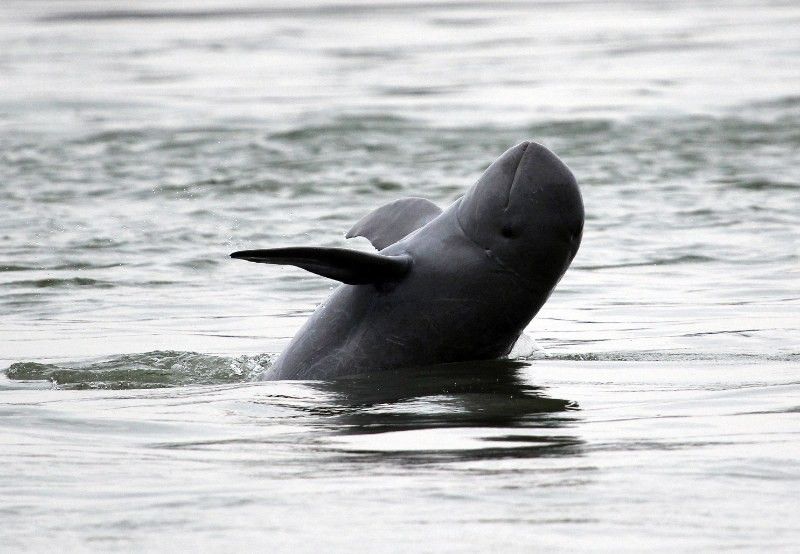Advocates push for stronger protection of disappearing Irrawaddy dolphins in Iloilo-Guimaras straits

MANILA, Philippines — Conservation groups called for greater protection of the critically endangered Irrawaddy dolphin subpopulation in Iloilo and Guimaras Straits as they warned the extinction of these rare cetaceans will result in a significant loss of marine biodiversity in the area.
There are only an estimated 10 to 13 individual Irrawaddy dolphins left in the area, and advocates fear the construction of a proposed bridge will lead to the disappearance of the subpopulation.
Earth Island Institute lamented the slow pace of action in saving the last remaining Irrawaddy dolphins in the coastal areas of Iloilo, Guimaras and Negros Occidental. The group noted that an average of one dolphin dies each year.
“To date, there has been very little action in convening the management agencies and implementing the plans laid out by scientists to save the last remaining Irrawaddies of Negros,” Trixie Concepcion, the regional director for Asia Pacific of Earth Island Institute, said on International Dolphin Day.
Advocates have been calling on the national government and local governments in Negros to declare the habitat of Irrawaddy dolphins as marine protected area, establish no-boat or slow-boat zones and no fishing areas, regulate fishing gears, and conduct regular monitoring of the species. They also call for livelihood support for fisherfolk who will be affected by the proposed MPA.
Dolphins perform vital ecosystem services such as keeping fish populations in balance. The presence of cetaceans is an indication of a healthy environment as it suggests the presence of a thriving fish population.
“The extirpation of the Irrawaddy [dolphins] in the Iloilo and Guimaras is a huge loss for biodiversity and marine ecosystems in this area,” Concepcion said.
The International Union for Conservation of Nature and the Department of Environment and Natural Resources classify the rare Irrawaddy dolphins (Orcaella brevirostris) as critically endangered.
Bridge construction
Mangrove Matters PH said the proposed Panay-Guimaras-Negros bridge threatens the Irrawaddy dolphins in Western Visayas.
The Philippine News Agency reported that the construction of the bridge—one of the priority projects of former President Rodrigo Duterte’s massive infrastructure program—will begin in 2025.
“[The] construction would produce noise pollution and these dolphins use echolocation to forage and navigate themselves. Such loud noises could lead them to stress and potentially to death,” said Matthew Vincent Tabilog, a marine biologist and founder of Mangrove Matters PH.
In 2020, the IUCN wrote a letter to former Public Works and Highways Secretary and now Senator Mark Villar, urging the government to consider alternative locations for the bridge entrances and exits or bridge alignments “that would allow for the safe and efficient transport of people and goods without sacrificing the region’s biodiversity.”
Tabilog urged the youth to take part in campaigns for the protection of Irrawaddy dolphins.
“This generation will suffer the long-term impacts of environmental degradation and we do not want to see a precious dolphin species go to extinction just because of anthropogenic threats,” he said.
Disappearing in Bicol, too
Irrawaddy dolphins are characterized by their gray or dark blue backs and pale bellies. They can adapt to different salinity levels, which allows them to thrive in areas where saltwater and freshwater meet such as the mouths of rivers and bays.
In the Philippines, Irrawaddy dolphins can also be found in Malampaya Sound in Palawan and in San Miguel Bay in Bicol region.
Scientists from the University of the Philippines-Diliman College of Science Institute of Environmental Science and Meteorology said in July that the Irrawaddy dolphins in Bicol region are fast disappearing. The team sighted only two Irrawaddy dolphins in the area in a span of four days.
“It is most likely that the Irrawaddy dolphins are using the offshore islands in the San Miguel Bay as a refuge area, and that there is now probably much less food for them there since it is one of the most over-exploited fishing grounds in the country,” IESM professor Lemnuel Aragones said.
- Latest
























